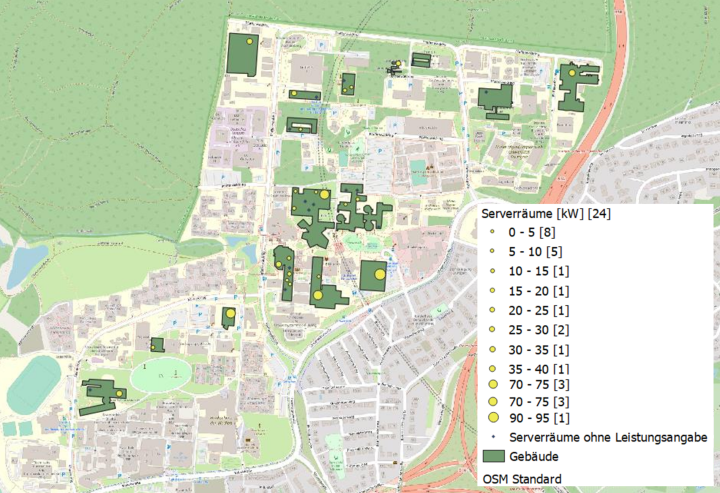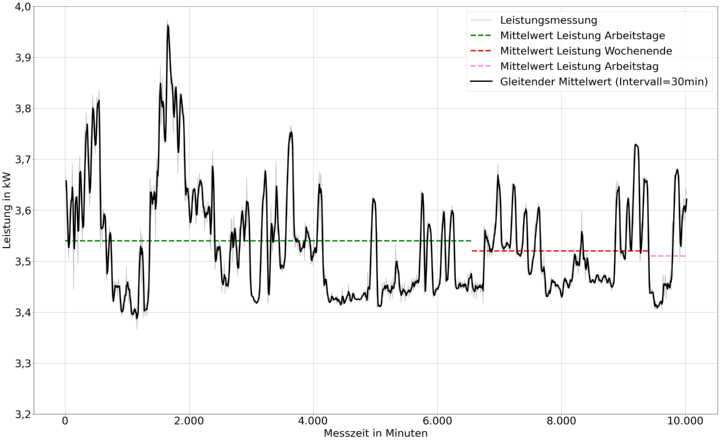In light of the energy crisis, also the University of Stuttgart is looking for ways to reduce consumption. Under the motto “Save energy. Together!”, the university management is calling on all university employees to support. As part of a student research project, researchers at the Institute of Energy Economics and the Rational Use of Energy (IER) have examined the energy-saving potential of the existing decentralized IT infrastructure at the University of Stuttgart. The results show that energy could indeed be saved by optimizing the decentralized IT systems.
The researchers considered a clustering scenario. If there is sufficient space available, several IT facilities located close to each other could join together and thereby save energy. In many server rooms, the existing cooling technology is oversized and leads to avoidable energy costs and greenhouse gas emissions because of low utilization. However, the respective cases would have to be considered individually.
Summary of the short study:
The IER is dealing with the energetic effects of digitalization. In addition to the central infrastructures of the High Performance Computing Center Stuttgart (HLRS) and the Technical Information and Communication Services (TIK), 149 institutes of the University of Stuttgart were assessed and analyzed. This provided an initial overview of the size, distribution, and performance capacity of the decentralized IT infrastructures. In addition, consumption was measured in selected IT rooms in the institutes. Potential energy savings were calculated based on three scenarios: hardware replacement, clustering, and centralization.
To collect data, an online survey of IT managers was conducted. The basic and technical data was then transferred to a database. This allowed the sites and performances to be visualized using a geographic information system (see Figure 1). A week-long power measurement campaign was then carried out in some server rooms in cooperation with the respective institutes.
The response rate to the online survey was 65%, and 57 of the responding institutes reported having decentralized IT systems. Another 40 institutes use only centralized IT systems. The average server room is 27.7 m² and has an installed IT performance of 22 kW (n = 31; n = 22). The installed IT performance ranged from 300 W to 95 kW (n = 22). Operators estimate that IT hardware utilization is 46% on average (n = 14). In three institutes with an installed performance of less than 3 kW, stand-alone computers are used as servers; in the remaining cases, classic servers in corresponding racks are used. The oldest IT hardware per server room is 13 years old on average (n = 20). This indicates that many facilities are still using inefficient hardware that is no longer state of the art. However, it is not possible to derive from this value what the overall age structure of the hardware in the institutes looks like. Hardware consolidation in conjunction with a hardware replacement could help reduce power consumption in these cases.
The power measurements in the server rooms of four institutes have shown that the energy demand is relatively constant regardless of day/night and working day/weekend (see for example Figure 2). However, it has not been known how high the actual utilization of the hardware was.
For the three scenarios – “hardware replacement”, “clustering”, and “centralization” – the energy and greenhouse gas savings potentials listed in Table 1 were calculated for the University of Stuttgart. The calculation for the hardware replacement scenario is based on the simplified assumption that only the main processors (CPU) are replaced, thus resulting in the energy savings. The resulting costs for the purchase and installation as well as any necessary hardware replacement are not taken into account in this case. Two values are given for the “clustering” and “centralization” scenarios because two options were considered at this point. For one option, the old hardware can still be used; for the other hand, new hardware can be used in these scenarios***. In any case, the performance capacity (measure is the floating point operations per second) is at least on the same level.
Tabelle 1: Einsparpotentiale (Strom und Treibhausgas) von drei Szenarien
|
Savings | Scenario |
“Hardware replacement” |
“Clustering” |
“Centralization” |
| Electricity [kWh/a] | 91.687 | 139.634 – 189.961 | 287.588 – 377.532 |
|
Greenhouse gas CO2 [t/a] |
14,76 | 22,48 – 29,78 | 46,30 – 60,78 |
Because of organizational or even application-specific requirements, the proposed scenarios – especially 2 and 3 – cannot necessarily be fully implemented and are thus not recommended. However, each institute should examine in detail what hardware is being used and whether a replacement would be possible and useful. In many server rooms, the existing cooling technology is not in line with the current needs and leads to avoidable energy costs and greenhouse gas emissions because of low utilization. Provided sufficient space is available for expansion, several facilities located in close proximity could be clustered. For potential clusters from Scenario 2, which are not cooled by the chiller network, additional energy savings between 41,927 to 55,943 kWh/a and greenhouse gas savings between 6.75 to 9.01 t/a can be achieved because of the higher utilization of the cooling machine.
The studies carried out at the University of Stuttgart have shown that (energetically) optimizing the decentralized IT systems can contribute to achieving the sustainability goals. However, each case must be considered individually because not all measures can be implemented in all places.
Student research project: Burrer, Fabian (2023): “Dezentrale IT-Anlagen an der Universität Stuttgart: Erfassung und Vorschläge zu ihrer energetischen Optimierung,” student research project, IER volume number 1158, University of Stuttgart, Stuttgart.
If you have any questions about the procedure or the results, please contact the authors directly:
- Prof. Peter Radgen
- Benjamin Ott (Supervisor)
- Fabian Burrer (Student)
Many thanks to Ralph Schelle (IER) for the metrological support of this study. Without his help, the power measurements would not have been possible.



